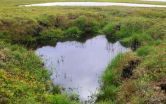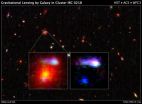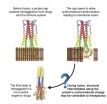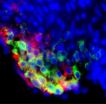(Press-News.org) New research, supported by the National Science Foundation (NSF), counters a widely-held scientific view that thawing permafrost uniformly accelerates atmospheric warming, indicating instead that certain Arctic lakes store more greenhouse gases than they emit into the atmosphere.
The study, published this week in the journal Nature, focuses on thermokarst lakes, which occur as permafrost thaws and creates surface depressions that fill with melted fresh water, converting what was previously frozen land into lakes.
The research suggests that Arctic thermokarst lakes are "net climate coolers" when observed over longer, millennial, time scales.
"Until now, we've only thought of thermokarst lakes as positive contributors to climate warming," said lead researcher Katey Walter Anthony, associate research professor at the University of Alaska Fairbanks Institute of Northern Engineering. "It is true that they do warm climate by strong methane emissions when they first form, but on a longer-term scale, they switch to become climate coolers because they ultimately soak up more carbon from the atmosphere than they ever release."
The researchers observed that roughly 5,000 years ago, thermokarst lakes in ice-rich regions of North Siberia and Alaska began cooling, instead of warming the atmosphere.
"While methane and carbon dioxide emissions following thaw lead to immediate radiative warming," the authors write, "carbon uptake in peat-rich sediments occurs over millennial time scales."
Using published data from the circumpolar Arctic, their own new field observations of Siberian permafrost and thermokarsts, radiocarbon dating, atmospheric modeling and spatial analyses, the research team studied how thawing permafrost is affecting climate change and greenhouse gas emissions.
Researchers found that "thermokarst basins switched from a net radiative warming to a net cooling climate effect about 5,000 years ago," according to their article, published online today. They found that high rates of carbon accumulation in lake sediments were stimulated by several factors, including "thermokarst erosion and deposition of terrestrial organic matter, nutrient release from thawing permafrost that stimulated lake productivity, and by slow decomposition in cold, anoxic lake bottoms."
"These lakes are being fertilized by thawing yedoma permafrost," explained co-author Miriam Jones, a research geologist for the U.S. Geological Survey. Yedoma is a type of permafrost that is rich in organic material. "So mosses and other plants flourish in these lakes, leading to carbon uptake rates that are among the highest in the world, even compared to carbon-rich peatlands."
The study also revealed another major factor of this process: when the lakes drain, previously thawed organic-rich lake sediments refreeze. The new permafrost formation then stores a large amount of carbon processed in and under thermokarst lakes, as well as the peat that formed after lake drainage.
Researchers note that the new carbon storage is not forever, since future warming will likely start re-thawing some of the permafrost and release some of the carbon in it via microbial decomposition.
As roughly 30 percent of global permafrost carbon is concentrated within 7 percent of the permafrost region in Alaska, Canada and Siberia, this study's findings also renew scientific interest in how carbon uptake by thermokarst lakes offsets greenhouse gas emissions. Through its data collection, the study expanded the circumpolar peat carbon pool estimate for permafrost regions by more than 50 percent.
INFORMATION:
NSF contributed to the research through an award made during International Polar Year (IPY), an international deployment of scientists from more than 60 nations to the Polar regions. NSF was the lead U.S. agency for the IPY. This international collaboration also received funding or support from the Alfred Wegener Institute, the University of Alaska Fairbanks, and the U.S. Geological Survey.
Certain Arctic lakes store more greenhouse gases than they release
New research contradicts long-held assumption about the role of thermokarst lakes
2014-07-31
ELSE PRESS RELEASES FROM THIS DATE:
NASA's Fermi space telescope reveals new source of gamma rays
2014-07-31
Observations by NASA's Fermi Gamma-ray Space Telescope of several stellar eruptions, called novae, firmly establish these relatively common outbursts almost always produce gamma rays, the most energetic form of light.
"There's a saying that one is a fluke, two is a coincidence, and three is a class, and we're now at four novae and counting with Fermi," said Teddy Cheung, an astrophysicist at the Naval Research Laboratory in Washington, and the lead author of a paper reporting the findings in the Aug. 1 edition of the journal Science.
A nova is a sudden, short-lived brightening ...
Study finds physical link to strange electronic behavior
2014-07-31
HOUSTON -- (July 31, 2014) -- Scientists have new clues this week about one of the baffling electronic properties of the iron-based high-temperature superconductor barium iron nickel arsenide. A Rice University-led team of U.S., German and Chinese physicists has published the first evidence, based on sophisticated neutron measurements, of a link between magnetic properties and the material's tendency, at sufficiently low temperatures, to become a better conductor of electricity in some directions than in others.
The odd behavior, which has been documented in a number ...
Hubble shows farthest lensing galaxy yields clues to early universe
2014-07-31
Astronomers using NASA's Hubble Space Telescope have unexpectedly discovered the most distant galaxy that acts as a cosmic magnifying glass. Seen here as it looked 9.6 billion years ago, this monster elliptical galaxy breaks the previous record-holder by 200 million years.
These "lensing" galaxies are so massive that their gravity bends, magnifies, and distorts light from objects behind it, a phenomenon called gravitational lensing. Finding one in such a small area of the sky is so rare that you would normally have to survey a region hundreds of times larger to find just ...
Researchers uncover clues to flu's mechanisms
2014-07-31
HOUSTON – (July 31, 2014) – A flu virus acts like a Trojan horse as it attacks and infects host cells. Scientists at Rice University and Baylor College of Medicine have acquired a clearer view of the well-hidden mechanism involved.
Their computer simulations may lead to new strategies to stop influenza, perhaps even a one-size-fits-all vaccine.
The discovery detailed this week in the Proceedings of the National Academy of Science shows the path taken by hemagglutinin, a glycoprotein that rides the surface of the influenza virus, as it releases fusion peptides to invade ...
UF study advances 'DNA revolution,' tells butterflies' evolutionary history
2014-07-31
GAINESVILLE, Fla. --- By tracing nearly 3,000 genes to the earliest common ancestor of butterflies and moths, University of Florida scientists have created an extensive "Tree of Lepidoptera" in the first study to use large-scale, next-generation DNA sequencing.
Among the study's more surprising findings: Butterflies are more closely related to small moths than to large ones, which completely changes scientists' understanding of how butterflies evolved. The study also found that some insects once classified as moths are actually butterflies, increasing the number of butterfly ...
NYU CDUHR researchers look at prescription opioid abuse among young adults in NYC
2014-07-31
The prevalence of heroin use has been rising steadily in the U.S in recent years. According to the National Survey on Drug Use and Health, the number of individuals reporting past year heroin use almost doubled between 2007 (373,000) and 2012 (669,000). Emerging evidence suggests the increase may be linked to prescription opioid (PO) users who transition from oral and/or intranasal PO use to heroin use, with POs providing the entryway to regular opioid use, and ultimately, heroin injection. This drug-use trajectory appears to have become increasingly common over the past ...
NYU research looks to combat US Latina immigrant obesity
2014-07-31
According to the U.S. Census Bureau, Latinos are the largest minority group in the United States, comprising 16.7% of the population. Approximately one-third of Latinos are obese and are 1.2 times as likely to be obese compared to non-Hispanic Whites.
NYU College of Nursing student researcher Lauren Gerchow, BSN, RN, MSN candidate, has sought to identify the factors that contribute to this problem by compiling a systematic review of qualitative studies that focused on food patterns in Latina women recently published in Nursing Research.
"The review focuses on women ...
Stanford professor finds that wildfires and other burns play bigger role in climate change
2014-07-31
It has long been known that biomass burning – burning forests to create agricultural lands, burning savannah as a ritual , slash-and-burn agriculture and wildfires – figures into both climate change and public health.
But until the release of a new study by Stanford University Civil and Environmental Engineering Professor Mark Z. Jacobson, the degree of that contribution had never been comprehensively quantified.
Jacobson's research, detailed in a paper published July 30 in the Journal of Geophysical Research: Atmospheres, is based on a three-dimensional computer model ...
Childhood coxsackie virus infection depletes cardiac stem cells and might compromise heart health in adults
2014-07-31
There is epidemiological evidence that links type B coxsackie virus (CVB) infection with heart disease, and research published on July 31st in PLOS Pathogens now suggests a mechanism by which early infection impairs the heart's ability to tolerate stress at later stages of life.
CVB infection is very common and affects mostly children. The symptoms range widely: over half of the infections are thought to be asymptomatic, the majority of children who get sick have only a mild fever, and a very small proportion get inflammation of the heart or brain. On the other hand, ...
Multidisciplinary study reveals big story of cultural migration
2014-07-31
Quantifying and transforming the history of culture into visual representation isn't easy. There are thousands of individual stories across millennia to consider, and some historical conditions are nearly impossible to measure.
Addressing this challenge, Dr. Maximilian Schich, associate professor of arts and technology at The University of Texas at Dallas, has brought together a team of network and complexity scientists to create and quantify a big picture of European and North American cultural history.
Schich, an art historian who works under the umbrella of the ...
LAST 30 PRESS RELEASES:
UMass Amherst chemists develop unique tool for studying RNA
Disappointment alters brain chemistry and behavior
A built-in odometer: new study reveals how the brain measures distance
Stress-related brain signals drive risk of cardiovascular disease in people with depression and anxiety
New details on role of fat transport molecules in Alzheimer’s onset
Study illuminates how an antiviral defense mechanism may lead to Alzheimer’s disease
Spot the males: New gene-editing method could transform mosquito control
AI learns to build simple equations for complex systems
NAU team releases 13 years of detailed U.S. CO2 emissions data
Unveiling how sodium-ion batteries can charge faster than lithium-ion ones
How do childcare tax credits affect children’s long-term health?
Can an electronic nose detect indoor mold?
Do natural disasters have long-term impacts on mortality in older adults?
Modification improves sodium‐ion batteries as an alternative to lithium-ion batteries
Parasports provide a range of benefits for people with cerebral palsy
How does grandparental care affect children’s health?
Why are there so many Nordic mediators?
Young shark species more vulnerable to extinction
Mobile fetal heart monitoring linked to fewer newborn deaths in Tanzania
Bluey’s dad offered professorial chair in archaeology at Griffith University
Beyond small data limitations: Transfer learning-enabled framework for predicting mechanical properties of aluminum matrix composites
Unveiling non-thermal catalytic origin of direct current-promoted catalysis for energy-efficient transformation of greenhouse gases to valuable chemicals
Chronic breathlessness emerging as a hidden strain on hospitals
Paleontologists find first fossil bee nests made inside fossil bones
These fossils were the perfect home for ancient baby bees
Not everyone reads the room the same. A new study examines why.
New research identifies linked energy, immune and vascular changes in ME/CFS
Concurrent frailty + depression likely boost dementia risk in older people
Living in substandard housing linked to kids’ missed schooling and poor grades
Little awareness of medical + psychological complexities of steroid cream withdrawal
[Press-News.org] Certain Arctic lakes store more greenhouse gases than they releaseNew research contradicts long-held assumption about the role of thermokarst lakes







